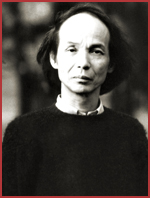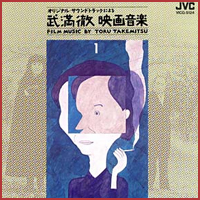
By JASON COMERFORD Takemitsu was long a devotee of progressive composers such as John Cage and Olivier Messiaen, whose broadening of musical boundaries gave him the “permission” he needed to develop his own increasingly experimental ideas. Like many serious composers of the time, Takemitsu accepted the occasional film-scoring opportunity to make easy money, but by the end of his life, he’d scored over 100 films, many of which (The Woman in the Dunes, Dodes’ ka-den, Black Rain) went on to be classics of Japanese cinema. One such assignment was for Masaki Kobayashi’s 1964 anthology film Kwaidan (a.k.a. Kaidan), The film was based a series of Japanese folk tales of the supernatural compiled by Lafcadio Hearn, an Irish expatriate who emigrated to the country in the late 1800s and became one of its foremost experts. The burgeoning musique concrete movement inspired Takemitsu to create a stunning collage of processed and manipulated natural sounds for electronics & tape, flavored with performances on traditional Japanese instruments including the shakuhachi (bamboo flute), the biwa and even vocal chants. The four-part film gave Takemitsu the opportunity to create four very different, but still interrelated, scores for each of the sections. Perhaps the most memorable of the quartet is the second episode, “The Woman of the Snow,” based on a classic Japanese folk tale about a woodcutter who vows not to speak of the strange woman that saved him from a deadly blizzard. As related by Kyoko Kozumi, in an essay on Kwaidan in the book Terror Tracks: Music, Sound and Horror Cinema: In order to create a sonic impression of a snowstorm, Takemitsu avoided using actual wind sounds and instead electronically manipulated shakuhachi sounds played by [soloist] Yokoyama. These sounds are so modulated in the final film that is difficult to identify their source. In addition, Takemitsu used a tapped sanukite (a stone from the Sanuki area of western Japan) to express the snow woman’s icy power. Kwaidan went on to win a Special Jury Prize at the Cannes Film Festival, as well as an Oscar nomination for Best Foreign Film; Stateside, it is now part of the Criterion Collection, and is viewable on Hulu. Takemitsu’s strikingly unique work for Kwaidan has been released, albeit only as part of a multi-disc collection of his film music available only in Japan. Regardless, Kwaidan is one of Takemitsu’s most intriguing efforts and is well worth tracking down. What do you think? Click here to submit a comment |
Click [here] to listen to a selection from
A prize will be awarded at the What do you think? Click here to submit a comment
Relevant Websites: KWAIDAN Criterion Bluray (Amazon) Wojciech Kilar listens to the |
|
| Howlin' Wolf | Congratulations to Tim, the winner of the Week 1 drawing for 13 Chills. The Week 1 prize compliments of the great team at Screen Archives Entertainment. COMING SOON: Details on the Grand Prize drawing at the conclusion of 13 Chills as well as the drawing for Week 2 (Friday, October 11 through Wednesday, October 16). |
|
| David W. | WOW! Again I have not seen this movie, but I love everything Japanese and need to include it in my collection. |
|
| Jeff | Damn. That is some creepy sounding stuff. If I were home alone in a dark house, I would NOT play this music.
Who am I kidding?!? I would too, and I'd love being freaked out by it!!! |
|
| Peloquin | I have never heard of this film, it's rather good and you shared a great piece with us. I am intrigued, thank you!! |
|
| Scott | I am completely unfamiliar with this movie and the music to go with it. But this is the fun part of 13 Chills, finding something new! It sounds very interesting to say the least! |
|
| Jonathan | With the recent Rising Sun released by Kritzerland, I am getting interested on Takemitsu's works. I haven't heard that one, but I will try to check it out. What a chill! | |
| Josh | Over the past few years, Toru Takemitsu has become one of my all-time favorite composers. I was lucky enough to be able to purchase a copy of the 6-CD set FILM MUSIC BY TORU TAKEMITSU before it became ridiculously expensive on the second-hand market, and it opened my eyes to a whole new world: Takemitsu's world. While the styles of music represented in his repertoire vary greatly, they all bear the stamp of his genius. He was a visionary and a conduit of the essence of musical expression, both in his film music and his concert music. Kwaidan is one that gets under my skin and into the folds of my frontal lobes and never really lets go even after the music stops, because it never really stops, does it? |
|
| Mike | This article inspired me to finally make a long overdue viewing of Kwaidan part of my Halloween horror film watching festivities. Classic film, beautifully shot and expertly scored. Long stretches of the film are marked by silence, making the presence of music when incorporated that much more effective. Particularly noteworthy I'd say were Takemitsu's pieces for the dramatic climaxes of "The Black Hair" and "Hoichi, The Earless" -- where the sfx are muted out and we're left with the horrific, spastic visuals and Takemitsu's unsettling, contrasting notes. | |


